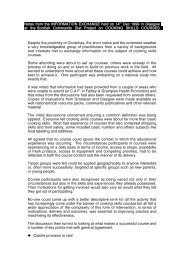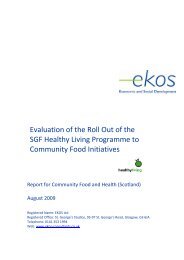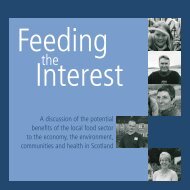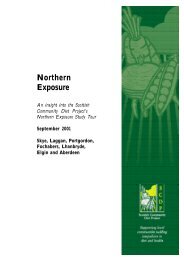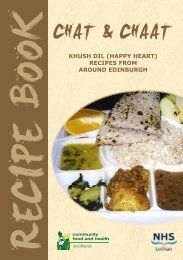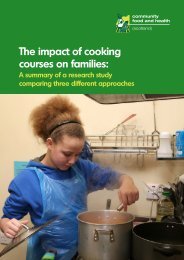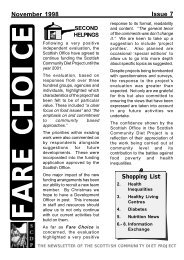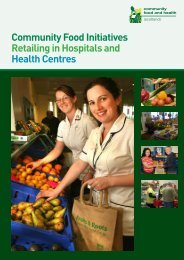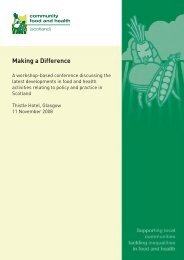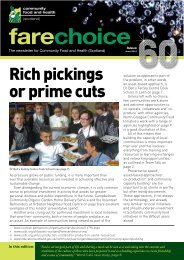fruitful participation - Community Food and Health
fruitful participation - Community Food and Health
fruitful participation - Community Food and Health
You also want an ePaper? Increase the reach of your titles
YUMPU automatically turns print PDFs into web optimized ePapers that Google loves.
<strong>fruitful</strong> <strong>participation</strong><br />
involving people in food<br />
<strong>and</strong> health work<br />
why you<br />
should do it<br />
how it’s<br />
been done<br />
where to<br />
get help<br />
to do it
community food<br />
<strong>and</strong> health (scotl<strong>and</strong>)<br />
Our overriding aim is to improve Scotl<strong>and</strong>’s food <strong>and</strong> health. We do<br />
this by supporting work within <strong>and</strong> with low-income communities that<br />
improves access to <strong>and</strong> take-up of a healthy diet.<br />
Major obstacles being addressed by community-based initiatives are:<br />
AVAILABILITY – increasing access to fruit <strong>and</strong> vegetables of an<br />
acceptable quality <strong>and</strong> cost<br />
AFFORDABILITY – tackling not only the cost of shopping, but also<br />
getting to the shops<br />
SKILLS – improving confidence <strong>and</strong> skills in cooking <strong>and</strong> shopping<br />
CULTURE – overcoming ingrained habits<br />
We help support low-income communities to:<br />
• identify barriers to a healthy balanced diet<br />
• develop local responses to addressing these barriers, <strong>and</strong><br />
• highlight where actions at other levels, or in other sectors<br />
are required<br />
We value the experience, underst<strong>and</strong>ing, skills <strong>and</strong> knowledge within<br />
Scotl<strong>and</strong>’s communities <strong>and</strong> their unique contribution to developing<br />
<strong>and</strong> delivering policy <strong>and</strong> practice at all levels.
contents<br />
Thanks! 4<br />
Who this is for 5<br />
Why you should get people more involved in your food <strong>and</strong> health work 7<br />
Current policy that supports <strong>participation</strong> 7<br />
The principles of <strong>participation</strong> 7<br />
Where our information comes from 9<br />
Examples of involving people in food <strong>and</strong> health work 11<br />
Where had PA been used <strong>and</strong> what had it been used for 11<br />
What worked 12<br />
Case studies 12<br />
• West Lothian <strong>Health</strong> Improvement Team 13<br />
• Wallyford <strong>Community</strong> Centre, East Lothian 15<br />
• <strong>Community</strong> <strong>Food</strong> Project, Fife 16<br />
• Tayside Primary Schools 16<br />
• Youth club, Inverness 17<br />
• Children’s Garden, Glasgow 18<br />
• Clinical St<strong>and</strong>ards Project, NHS Tayside 19<br />
• Drumchapel <strong>Health</strong>y Living Initiative, Glasgow 20<br />
• Dysart <strong>Food</strong> <strong>and</strong> <strong>Health</strong> Initiative, Fife 21<br />
Problems <strong>and</strong> solutions 22<br />
The case for involving people 23<br />
References <strong>and</strong> further information 25
thanks!<br />
A big thanks to all the people who contributed to this publication. We would particularly<br />
like to thank those who energetically attended various follow-up days after attending one<br />
of our annual residential courses, <strong>and</strong> who also sent us information on how they had<br />
engaged with their communities.<br />
A special thanks to those who provided case studies.<br />
We also appreciate Vikki Hilton’s contribution – for being an energetic trainer, <strong>and</strong> for<br />
giving her comments <strong>and</strong> assistance with this publication.<br />
<strong>Community</strong> <strong>Food</strong> <strong>and</strong> <strong>Health</strong> (Scotl<strong>and</strong>), May 2007<br />
There is a strong national commitment to<br />
engaging with <strong>and</strong> involving people <strong>and</strong><br />
communities in all aspects of health… It is very<br />
important that this commitment is not lost in the<br />
complexity of organisational partnership working<br />
<strong>and</strong> that people <strong>and</strong> communities are involved<br />
<strong>and</strong> have a role in shaping the action <strong>and</strong><br />
delivering change. Ideally, we wish to empower<br />
<strong>and</strong> support communities to be involved in<br />
developing initiatives <strong>and</strong> solutions.<br />
Scottish Executive, 2003. Improving <strong>Health</strong> in Scotl<strong>and</strong>:<br />
The Challenge (online) Edinburgh: Scottish Executive.<br />
Available from: www.scotl<strong>and</strong>.gov.uk/Resource/Doc/47034/0013854.pdf<br />
(Accessed 27 April 2007).
who this is for<br />
This publication gives you a snapshot of how getting people involved in decision-making<br />
around food <strong>and</strong> health issues can be enjoyable, democratic, empower those involved <strong>and</strong><br />
make a difference. The publication discusses approaches <strong>and</strong> methods that are effective<br />
at involving people <strong>and</strong> that are different to some of the more traditional consultation <strong>and</strong><br />
planning methods, such as questionnaires or public meetings. Although these traditional<br />
methods can be extremely useful, this publication promotes approaches <strong>and</strong> methods that<br />
are more visual <strong>and</strong> can attract people to take part <strong>and</strong> share their views. You could use<br />
these approaches in many types of situations, from town planning or business planning, to<br />
finding out how to market a fruit <strong>and</strong> vegetable stall or planning or evaluating work within a<br />
team. You will gain an underst<strong>and</strong>ing of how to involve people, whether you are a volunteer<br />
for a cookery club, or a decision maker for a <strong>Community</strong> <strong>Health</strong> Partnership.<br />
Everything in the publication is based on the experiences of people who have received<br />
training on how to use participatory methods <strong>and</strong> approaches of engaging with the<br />
community. These people have then gone back to their communities or workplaces <strong>and</strong><br />
used what they learnt. Although this publication is not a ‘how to do’ participatory planning<br />
or consultation book, it will show you how people have used participatory approaches in<br />
real life – what worked, what they learnt <strong>and</strong> what the impact was. It will also show you<br />
where to go next if you want to learn more.<br />
The first section outlines how the principle of involving the community in decision-making<br />
is supported by current policy, the basic principles of <strong>participation</strong>, how <strong>participation</strong> in<br />
decision-making has developed, <strong>and</strong> how we gathered the information in this publication.<br />
The second section highlights experiences of using participatory methods <strong>and</strong><br />
approaches in work <strong>and</strong> community lives.<br />
The third section shows where to go for more information on participatory techniques<br />
<strong>and</strong> approaches, community development, training <strong>and</strong> policy.
why you should get people more<br />
involved in your food <strong>and</strong> health work<br />
Getting people involved <strong>and</strong> participating in<br />
food <strong>and</strong> health work can be challenging,<br />
whether this is involving people in a local<br />
nutrition strategy or volunteering for a food<br />
co-op. However, a study of food projects<br />
by McGlone <strong>and</strong> others (1999) showed that<br />
involving local people <strong>and</strong> working together<br />
with them could make a difference between<br />
the success <strong>and</strong> failure of a project. Therefore,<br />
it is certainly worthwhile pursuing. This is why<br />
involving people in the planning process is<br />
supported by current policy in many areas<br />
of work.<br />
At the end of the day,<br />
I get what I need in order to<br />
deliver my objectives but it<br />
has been done in an involving<br />
<strong>and</strong> democratic way.<br />
Participatory Appraisal (PA) practitioner<br />
Current policy that<br />
supports <strong>participation</strong><br />
In the last few years, changes have been made<br />
to the way that local services are structured,<br />
such as the introduction of <strong>Community</strong><br />
Planning Partnerships <strong>and</strong> <strong>Community</strong> <strong>Health</strong><br />
Partnerships. Their aim is to involve the<br />
community more in decision-making. These<br />
new structures require agencies to consider<br />
ways in which they can build relationships<br />
with their local community <strong>and</strong> partners. We<br />
also now have ‘St<strong>and</strong>ards of <strong>Community</strong><br />
Engagement’ (Communities Scotl<strong>and</strong>, 2005)<br />
<strong>and</strong> ‘Patient Focus <strong>and</strong> Public Involvement’<br />
(NHS Quality Improvement Scotl<strong>and</strong>, 2006)<br />
which have been produced with the aim of<br />
making sure that local people or patients<br />
have a say in decisions that affect them within<br />
these new structures. The ‘Developing <strong>Health</strong>y<br />
Communities Task Group’ was a mixed<br />
agency group that came together as a result<br />
of the ‘community-led’ pillar of the Scottish<br />
Executive policy ‘Improving <strong>Health</strong> in Scotl<strong>and</strong>:<br />
The Challenge’ (2003). A report (<strong>Health</strong>y<br />
Communities: A Shared Challenge, 2006)<br />
from its work showed that involving the local<br />
community in shaping health improvement<br />
services can result in a service more<br />
appropriate to the local community. The service<br />
is also more likely to reach its target audience.<br />
The same report showed that community<br />
members who get involved in local health<br />
improvement services also benefit. The benefits<br />
to them include more confidence, development<br />
of skills <strong>and</strong> a sense of belonging.<br />
The principles of <strong>participation</strong><br />
Although there are now plenty of policies<br />
that support the view that people need to be<br />
involved in shaping local services, there are a<br />
variety of ways of achieving this. One way is to<br />
carry out surveys <strong>and</strong> consultations <strong>and</strong> hold<br />
public or group meetings. These traditional<br />
methods can be effective at gathering<br />
information. However, this publication promotes<br />
approaches <strong>and</strong> methods that can be used<br />
alongside traditional methods to reach a wider<br />
range of people. Participation is also not just<br />
about collecting local opinions. Participation is<br />
also about having the opportunity to get more<br />
involved, such as being part of a group that<br />
makes changes.
Getting people more actively involved in<br />
decision-making can happen in several ways.<br />
Titterton <strong>and</strong> Smart (2006) describe how<br />
local people can be trained to use research<br />
methods <strong>and</strong> then supported to undertake<br />
consultation or research in their area. This<br />
approach can result in both effective research<br />
as well as building local skills <strong>and</strong> involvement.<br />
The participatory approaches discussed in this<br />
publication are often known as ‘Participatory<br />
Appraisal’ (PA). PA is one of a family of<br />
methods <strong>and</strong> approaches that can help people<br />
to share <strong>and</strong> discuss their experiences <strong>and</strong><br />
plan <strong>and</strong> implement changes. Other methods<br />
of engaging with people share some of the<br />
principles <strong>and</strong> methods of PA. Any process that<br />
aims to involve people in decision-making <strong>and</strong><br />
implementing changes, <strong>and</strong> has the underlying<br />
principle that local people are experts on their<br />
own lives, has a similarity with PA.<br />
Participatory appraisal was developed in<br />
Third World countries where it was known<br />
as Participatory Rural Appraisal. It was used<br />
there to engage with local people <strong>and</strong> to work<br />
in partnership with them in order to respond<br />
to local needs. Participatory Rural Appraisal<br />
was used to make sure that decision-making<br />
included the views of the whole community<br />
<strong>and</strong> that development was not shaped by<br />
outsiders or more dominant members of the<br />
community (Caldwell, McCann, Flower, 2003).<br />
Some of the approaches <strong>and</strong> ideals that are<br />
central to community development are similar<br />
to the underlying principles of PA.<br />
Many writers (for example, <strong>Health</strong> Scotl<strong>and</strong>,<br />
<strong>and</strong> others, 2003) say that the values of a<br />
community development approach include<br />
working <strong>and</strong> learning together, <strong>and</strong> respecting<br />
a person’s right to participate in decisions that<br />
will affect their lives. According to Johnson <strong>and</strong><br />
others (2000) these values are the same in PA.<br />
PA approaches <strong>and</strong> methods often use<br />
visual or active techniques to engage with<br />
people <strong>and</strong> to find out their opinions. An<br />
example of using these techniques in a street<br />
survey would be to invite people to add their<br />
comments or draw pictures on a graffiti/sticky<br />
wall. They could also put a mark on a street<br />
map to indicate where they lived to monitor<br />
who was taking part, or to find out where they<br />
wanted a particular service. An example of<br />
using these techniques in a meeting would be<br />
to ask people to write comments <strong>and</strong> ideas on<br />
‘Post-it’ notes or pieces of paper <strong>and</strong> put them<br />
on the wall or a table. The group can then<br />
discuss <strong>and</strong> sort out these notes together into<br />
categories. This can help find out shared views<br />
<strong>and</strong> these notes can then be sorted out again<br />
in order to agree on priorities for action. There<br />
are many other existing PA methods. However,<br />
the advantage of PA is that you can create<br />
new methods or adapt existing ones. For<br />
example, on a PA student placement, trainees<br />
asked high school pupils in the street to draw<br />
a picture of their lunch on a paper plate.<br />
The young people wrote how they chose their<br />
lunch on the back of the plate.
PA methods <strong>and</strong> approaches can also be very<br />
effective at involving people whose voices are<br />
least likely to be heard. Many of the methods<br />
are more accessible to people who may have<br />
basic literacy skills.<br />
PA can be used at many levels. At its most<br />
comprehensive it can involve local people <strong>and</strong><br />
staff learning PA together <strong>and</strong> following this up<br />
with community consultation <strong>and</strong> engagement.<br />
This was how Cultenhove Opportunities<br />
Partnership <strong>and</strong> Stirling <strong>Community</strong> Planning<br />
Partnership (2005) carried out PA in Cultenhove.<br />
On another level, individual staff or volunteers<br />
can attend a PA course <strong>and</strong> then introduce<br />
the approaches <strong>and</strong> methods into their area of<br />
work, organisation or local community. This is<br />
how <strong>Community</strong> <strong>Food</strong> <strong>and</strong> <strong>Health</strong> (Scotl<strong>and</strong>)<br />
delivered the annual PA course.<br />
A review of PA by the partners of the Oxfam<br />
UK Poverty Programme (2001) warned that<br />
participatory approaches must be used with<br />
caution. Engaging with people <strong>and</strong> finding<br />
out their views <strong>and</strong> then not acting on these<br />
views can lead to frustration <strong>and</strong> cynicism. An<br />
even worse scenario is listening to people then<br />
taking action that is completely different to<br />
these views. This is, of course, a problem with<br />
any consultation. With any engagement with<br />
local groups or individuals, caution must be<br />
taken to avoid raising expectations that will not<br />
be fulfilled.<br />
Where our information<br />
comes from<br />
For the past four years, <strong>Community</strong> <strong>Food</strong><br />
<strong>and</strong> <strong>Health</strong> (Scotl<strong>and</strong>), formerly known as the<br />
Scottish <strong>Community</strong> Diet Project, has organised<br />
an annual five-day residential course. The course<br />
is open to those working around food <strong>and</strong> health<br />
who wish to learn more about participatory ways<br />
of engaging with people by using participatory<br />
appraisal approaches <strong>and</strong> methods.<br />
Since 2003, 56 people have taken part in the<br />
PA residential course. Six months after each<br />
residential course, participants are invited back<br />
to a follow-up day, to share what they have<br />
learnt. In December 2006, we were able to<br />
contact 45 people who had taken part in the<br />
residential course.<br />
We wanted to find out how they had used<br />
PA approaches <strong>and</strong> methods in their work or<br />
organisations. These PA practitioners were<br />
invited to attend another follow-up day, where<br />
they would have the opportunity to share<br />
<strong>and</strong> learn again with those who had attended<br />
any of the PA courses since 2003. Thirteen<br />
people were able to attend the day <strong>and</strong> 26<br />
people provided brief reports on how they had<br />
used PA since attending their courses. This<br />
publication uses the information gathered from<br />
follow-up days, brief reports <strong>and</strong> case studies<br />
to highlight what has been learnt.<br />
<strong>Community</strong> development<br />
recognises that everyone<br />
has the right to have their<br />
say – but it can be difficult<br />
to make sure that everyone<br />
has the opportunity to<br />
get their say. Participatory<br />
methods can help.<br />
PA practitioner<br />
participate
11<br />
examples of involving<br />
people in food <strong>and</strong> health work<br />
Where has PA been used <strong>and</strong><br />
what has it been used for<br />
PA has been used by those who contributed<br />
to this publication in a vast variety of<br />
situations, with many different people <strong>and</strong><br />
for a range of reasons.<br />
Quite a few people had used PA with children<br />
<strong>and</strong> young people. Some used it with mixed<br />
audiences or at public events <strong>and</strong> others used<br />
the approaches <strong>and</strong> methods to develop action<br />
plans. Many people had used PA methods in<br />
their team or own work for project planning<br />
or decision-making. A few people had also<br />
incorporated PA methods into teaching – such<br />
as using a body map for health education with<br />
young people, or using a variety of methods<br />
with students to create a workshop atmosphere<br />
as an alternative to a traditional lecture.<br />
PA was popular for carrying out evaluation,<br />
such as at cooking sessions, where a few had<br />
used an H Diagram as an efficient way to<br />
find out what people thought of sessions <strong>and</strong><br />
to suggest improvements. One person had<br />
used PA to find out local people’s views on<br />
local transport <strong>and</strong> food shopping. Another<br />
What is a body map<br />
A body map (pictured) is an outline of a<br />
body. Individuals <strong>and</strong> groups are asked<br />
to draw or add comments to the body or<br />
on the outside of the body. For example,<br />
people are asked to add comments or draw<br />
pictures that show how they make food<br />
choices. Outside influences can be placed<br />
outside the body <strong>and</strong> personal choices or<br />
needs could be placed inside the body.<br />
What is an H Diagram<br />
An H Diagram (pictured) asks one question.<br />
It provides space for positive, negative views<br />
<strong>and</strong> suggested changes relating to this<br />
question. It also often has a scale from 0 to<br />
10, with 0 being a negative response <strong>and</strong> 10<br />
a positive response. For example, a question<br />
could be ‘what do you think about food<br />
shops in this area’ The person answering<br />
the question could rate the food shops as<br />
6 out of 10, they could add positive <strong>and</strong><br />
negative comments in the spaces provided<br />
<strong>and</strong> they might put lots of ideas about how<br />
food shops in the area could be improved.<br />
An H diagram could be used in various ways,<br />
including individually or in a group setting.
12<br />
person used PA at a public event to find out if<br />
local people wanted a food co-op in their area.<br />
They encouraged people to vote for or against<br />
the co-op by asking them to use beans as<br />
counters in ‘yes’ or ‘no’ jars.<br />
At the all-day event for those who had<br />
attended the course, the 13 participants<br />
were asked why they still continued to use<br />
PA methods <strong>and</strong> approaches <strong>and</strong> what they<br />
found the benefits were. The most popular<br />
comments were that the PA process involved<br />
people by either engaging with them, by being<br />
democratic or by sharing views.<br />
What worked<br />
Overall those who had used PA in their work<br />
or communities found that it was enjoyable<br />
for everyone involved <strong>and</strong> people were easily<br />
engaged. It had helped people think more<br />
about what they were trying to achieve overall.<br />
It had also helped to make projects belong to<br />
those using them rather than the person paid to<br />
do the work. PA methods were highlighted as<br />
being suitable for all ages, although one person<br />
had found that body mapping was particularly<br />
good with young people. Another said that PA<br />
sets out a picture quickly of what people want.<br />
Others liked certain PA methods more than<br />
others. The H Diagram was popular with many,<br />
some were less keen on body maps.<br />
I have used it (PA)<br />
extensively at<br />
work, with friends<br />
<strong>and</strong> at home.<br />
PA practitioner<br />
involve<br />
action<br />
Case studies<br />
The case studies that follow give more details<br />
on how PA approaches have been useful for<br />
involving people with planning, evaluating<br />
<strong>and</strong> changing food <strong>and</strong> health work. Because<br />
many of the PA practitioners are involved in<br />
other areas of work as well as food <strong>and</strong> health;<br />
some of the case studies reflect their uses of<br />
PA throughout their organisations.
13<br />
Image supplied by Vikki Hilton<br />
West Lothian <strong>Health</strong><br />
Improvement Team<br />
This case study from West Lothian shows how<br />
three members of a multi-disciplinary team<br />
used participatory appraisal (PA) methods<br />
<strong>and</strong> approaches with different groups that<br />
they work with, <strong>and</strong> for different purposes.<br />
Members of the West Lothian <strong>Health</strong><br />
Improvement team have been using<br />
participatory approaches in their work for<br />
several years. A few members of the team<br />
attended the CFHS participatory appraisal<br />
course, whilst others had learnt the methods<br />
from other team members or elsewhere. Some<br />
had a community development background <strong>and</strong><br />
found that participatory methods worked well<br />
alongside community development approaches.<br />
In general, the team’s work around food <strong>and</strong><br />
health includes servicing <strong>and</strong> developing a<br />
network of food co-operatives, running a ‘Get<br />
Cooking’ programme <strong>and</strong> delivering health<br />
promotion activities, as well as promoting food<br />
access more strategically.<br />
Using PA in working with cookery classes<br />
(or training)<br />
The Get Cooking programme aims to invest<br />
in local people by training them to run their<br />
own cookery classes. Cooking tutors learn<br />
participatory methods in order to find out<br />
the training needs of potential new groups <strong>and</strong><br />
to carry out evaluation during or at the end of the<br />
Get Cooking courses. The most popular method<br />
for both of these is the H Diagram. Completing<br />
this chart/diagram collectively or in small groups<br />
helped to stimulate discussion as well as helping<br />
to make sure that everyone gets what they want<br />
out of the Get Cooking sessions.<br />
Using PA in working with food co-ops<br />
(or developing new projects)<br />
The team found that participatory techniques<br />
are particularly useful for developing new or<br />
existing food co-operatives. For example,<br />
members of the team <strong>and</strong> volunteers used<br />
a variety of participatory methods to find out<br />
if local people wanted to develop or use a<br />
food co-op in their area. The team found that<br />
participatory methods worked well to involve<br />
people <strong>and</strong> to get a clear idea of what local<br />
people wanted. After a series of consultation<br />
events about the potential new food co-op,<br />
the team planned how to tell the community<br />
what had been found out. However, the local<br />
people who had started to get involved with<br />
developing the food co-op were keen to take<br />
action <strong>and</strong> open the food co-op, <strong>and</strong> did not<br />
want to be involved in any more activities or<br />
events. Although one of the principles of PA<br />
is letting people know what views have been<br />
heard in the community, another important<br />
feature of PA is making sure that community<br />
members control how <strong>and</strong> when they are<br />
involved. In this case, the group did not want<br />
any more events or activities, as they believed<br />
that enough had already been done. The new<br />
group then set up their food co-op.<br />
PA gets into everything<br />
Here are a couple of examples of how<br />
members of the team have used PA methods<br />
in other areas of their work.<br />
In schools, they asked the children to draw a<br />
map of their area so that they could talk about<br />
what (food related) issues were important to<br />
them. Most of the children were happy to do<br />
this although one or two children were less<br />
comfortable with this approach because they<br />
were self-conscious about their drawing skills.
14<br />
When members of the team used a graffiti/<br />
sticky wall to present their work to the<br />
local CHCP (<strong>Community</strong> <strong>Health</strong> <strong>and</strong> Care<br />
Partnership), they found that adding posters,<br />
diagrams, arrows <strong>and</strong> photos to the sticky<br />
wall helped to ‘build a picture’ of their work<br />
<strong>and</strong> they preferred using this method of<br />
presentation compared with using a Power<br />
Point presentation.<br />
inform<br />
discuss<br />
Top tips<br />
• If you are running an event <strong>and</strong> plan to use<br />
PA methods, particularly a sticky wall, go<br />
<strong>and</strong> see the building first to make sure that<br />
you have space <strong>and</strong> permission to use the<br />
wall space. Also, when using a sticky wall<br />
for presentations, don’t put too much on the<br />
sticky wall, otherwise it will fall down.<br />
• When using PA methods at a meeting or at<br />
an event, have plenty of table space to use<br />
large sheets of paper, then there is no need<br />
to make people crawl around on the floor.<br />
• Make sure that anyone conducting PA<br />
knows the principles, make sure that they<br />
don’t ‘lead’ people, use leading questions<br />
or ‘keep hold of the pen’.<br />
• Don’t ask too many questions <strong>and</strong> keep the<br />
questions open ended so that you get lots<br />
of opinions.<br />
• Explain to people what you are doing <strong>and</strong><br />
why, take plenty of pens, <strong>and</strong> use coloured<br />
Post-it notes, for colour coding.<br />
• It is important to leave good instructions<br />
or someone to explain how a particular<br />
process works. The team found that when<br />
PA type sheets were left in a community<br />
centre for people to complete, not all the<br />
sheets were filled in <strong>and</strong> tracking who had<br />
taken part was particularly difficult.
15<br />
Wallyford <strong>Community</strong><br />
Centre, East Lothian<br />
This case study from Wallyford <strong>Community</strong><br />
Centre shows what happened when this<br />
community centre hosted a participatory<br />
appraisal (PA) training placement <strong>and</strong> how PA<br />
is used in many areas of the Centre’s work.<br />
PA placement<br />
In October 2005 a PA study placement was set<br />
up in Wallyford. The aim was for those attending<br />
a PA residential course to practice their skills<br />
<strong>and</strong> for local people to express their views.<br />
The village of Wallyford is in the process of being<br />
developed into a small town <strong>and</strong> within the<br />
next ten years the population will double from<br />
its current size of 2,500 to around 5,000. The<br />
local authority planning team was keen to know<br />
what food shopping arrangements the people of<br />
Wallyford wanted in this new, larger community.<br />
It was a key partner in setting up the placement<br />
<strong>and</strong> put forward the questions that they wished<br />
the Wallyford residents to answer.<br />
The trainee PA team were asked to engage<br />
with a cross-section of the community to:<br />
• find out any current barriers to a healthy diet<br />
<strong>and</strong> how these could be overcome;<br />
• <strong>and</strong> find out what food shops people<br />
wanted in the new larger community.<br />
The PA team were asked to remain neutral<br />
regarding these views.<br />
Over a day <strong>and</strong> a half, the PA team engaged<br />
with people in many situations <strong>and</strong> venues.<br />
In total, they engaged with 209 people, half of<br />
these were primary-aged children, <strong>and</strong> the other<br />
half were made up of a good mix of ages. They<br />
spoke with people from all areas of the village.<br />
They used a variety of methods <strong>and</strong> processes<br />
to engage with people. One approach was to<br />
ask people to draw a map of where they lived<br />
<strong>and</strong> to use Post-it notes to show the things<br />
that they liked <strong>and</strong> didn’t like on their map.<br />
They also used H Diagrams to find out the<br />
population’s likes <strong>and</strong> dislikes. In the street<br />
they displayed a map of the village <strong>and</strong> asked<br />
people to indicate their preferred location for<br />
future shops.<br />
Finally, they showed the results of their PA<br />
work at a public display in the community<br />
centre, where people had the opportunity to<br />
see the results <strong>and</strong> to add comments.<br />
Recommendations from the results included<br />
more individual shops, with longer opening times,<br />
traffic calming <strong>and</strong> more crossings, community<br />
police <strong>and</strong> a warden. Further work was also<br />
recommended to engage with more people<br />
between the age of 19–25, as the team had not<br />
talked with many people in this age group.<br />
Results from the PA placement<br />
The report was sent to the local authority<br />
planning department, who will use it for<br />
background information. Reports were also<br />
sent to other organisations, including the<br />
<strong>Community</strong> Planning Partnership.<br />
PA everywhere<br />
Generally, since then, PA methods <strong>and</strong><br />
approaches have been used throughout<br />
the community centre <strong>and</strong> as a community<br />
development tool with the local population.<br />
The methods have been used for team work,<br />
family days <strong>and</strong> in the youth club. H Diagrams<br />
are used by youth club staff to evaluate each<br />
youth club session. Prior to using H Diagrams<br />
there had been limited formal evaluation. A<br />
result of using the H Diagram regularly was<br />
that youth club staff were more informed <strong>and</strong><br />
therefore more able to tackle any problems,<br />
such as challenging behaviour.
16<br />
PA approaches were also used in a rural<br />
development planning day that the community<br />
centre staff facilitated. The 30 people that<br />
attended this event were required to assist in<br />
the development of a rural development plan<br />
for the local authority. The main objective of the<br />
day concerned showing how the Scottish Rural<br />
Development programme was linked to key<br />
local concerns such as community planning<br />
<strong>and</strong> the Leader+ programme. This was a long<br />
but productive day. It had three facilitators <strong>and</strong><br />
three groups. They used a variety of methods<br />
to engage with people, including mapping,<br />
voting <strong>and</strong> a matrix to capture people’s views.<br />
The day went well, <strong>and</strong> the facilitator believes<br />
that less would have been achieved if they had<br />
used other methods, such as focus groups.<br />
The PA methods were particularly good for<br />
making sure that everyone had their say <strong>and</strong><br />
that the discussions were not dominated by<br />
any individuals. They also found that although<br />
those attending were not familiar with PA<br />
methods, they had no problems underst<strong>and</strong>ing<br />
the tasks.<br />
Top tip<br />
• Good planning for a session that uses PA<br />
methods is essential. Although planning for<br />
PA events can be time-consuming, it does<br />
pay off.<br />
<strong>Community</strong> <strong>Food</strong><br />
Project, Fife<br />
My main aims were to find out:<br />
1. What activities the community would<br />
like to see in relation to food activities.<br />
2. How they saw themselves linking in<br />
with the project.<br />
3. And how Fife <strong>Community</strong> <strong>Food</strong> Project<br />
in Levenmouth could be improved.<br />
I used a sticky wall with three headings.<br />
The response from the community was<br />
positive <strong>and</strong> gave me an insight from<br />
participants on what activities they<br />
would like to see in the future, which has<br />
enabled me to plan, link in with other<br />
projects <strong>and</strong> organisations.<br />
Celeste Thomson<br />
engage<br />
Tayside primary schools<br />
I had been asked to work with Primary<br />
schools in Perth <strong>and</strong> Kinross to find out<br />
what the children thought of the school<br />
meal service. The team used several<br />
participatory appraisal methods, one of<br />
these was to give the children cameras<br />
<strong>and</strong> ask them to take pictures of things<br />
that they liked <strong>and</strong> things that they didn’t<br />
like about the school meal service. The<br />
photos were then placed on a sticky wall<br />
in the classroom. Statements about the<br />
meal service were placed on the wall <strong>and</strong><br />
the children were encouraged to agree or<br />
disagree with the statements or to add<br />
some comments of their own. Compared<br />
to previous years, the team agreed that<br />
this consultation exercise had been<br />
very successful. They believed this was<br />
partly because the pupils ‘owned’ the<br />
information. The pupils were then given<br />
the task to come up with an action plan<br />
to try <strong>and</strong> address the issues that they<br />
had identified.<br />
Lyndsey Robinson
17<br />
Youth Club, Inverness<br />
<strong>Food</strong> First is a healthy eating initiative run<br />
by the voluntary organisation, Partnerships<br />
for Wellbeing, in Inverness. <strong>Food</strong> First have<br />
used participatory appraisal (PA) methods<br />
<strong>and</strong> approaches throughout their work, this<br />
case study is an example of how they used PA<br />
with young people to help them decide what<br />
health activities they would like, <strong>and</strong> to get<br />
these activities started.<br />
Girls at the youth club were invited to take part<br />
in choosing future activities around health (the<br />
boys were out doing other activities). They<br />
used body mapping to help them think about<br />
health issues that affected them.<br />
The 14 girls, mainly in their teens, were asked<br />
to split into three groups <strong>and</strong> a volunteer from<br />
each group was asked to lie on a large sheet<br />
of paper (wall lining paper is ideal). Another<br />
member of the group then drew around them<br />
to create a body outline shape. Everyone was<br />
asked to draw on or around the body outline<br />
things that affected their body. They were<br />
then given:<br />
• 3 pink Post-it notes to write things that<br />
make it easy to have a healthy body;<br />
• 3 blue Post-it notes to write things that<br />
make it difficult to have a healthy body; <strong>and</strong><br />
• 3 yellow Post-it notes for ideas or changes<br />
they would like to make.<br />
The girls wrote down <strong>and</strong> discussed a<br />
variety of issues that they believed affected<br />
their health <strong>and</strong> body image including<br />
bullying, junk food <strong>and</strong> thin models. They<br />
suggested that exercise, information on<br />
hygiene, healthy options in the tuck shops<br />
<strong>and</strong> cooking sessions would address some<br />
of these issues. The following week the girls<br />
had another discussion to prioritise <strong>and</strong> plan<br />
these activities. One of the actions that the<br />
girls agreed to was to make healthy options<br />
available in the youth club’s tuck shop. They<br />
arranged to make smoothies, fruit juices, fruit<br />
kebabs <strong>and</strong> have lower fat crisps available.<br />
Since then, the changes that they have made<br />
have been popular with both boys <strong>and</strong> girls<br />
in the youth club, particularly the fruit kebabs<br />
<strong>and</strong> smoothies. The young people are also<br />
involved in preparing these foods. Prior to<br />
the girls’ discussions, the youth club staff<br />
had considered offering healthier options<br />
in the tuck shop but did not think that the<br />
young people would be interested. Because<br />
the girls decided for themselves that they<br />
wanted healthier foods, these changes were<br />
acceptable <strong>and</strong> also resulted in the young<br />
people being actively involved in making, as<br />
well as promoting, healthier foods. The young<br />
people are also in the process of addressing<br />
some of the other issues that came up in the<br />
discussions.<br />
Top tips<br />
• Keeping boys <strong>and</strong> girls in separate groups<br />
when discussing health issues can be<br />
helpful in some situations. In the above<br />
example, the girls refused to carry on their<br />
discussion when the boys returned from<br />
their own activities.<br />
• Body mapping – draw around people with a<br />
pencil – this stops ink getting on clothes.<br />
• Take pictures of your work (with the<br />
permission of those in the pictures) to help<br />
record what happened.
18<br />
Children’s Garden,<br />
Glasgow<br />
This case study from the Children’s Garden<br />
in Glasgow shows how this community group<br />
used participatory appraisal (PA) methods<br />
<strong>and</strong> approaches to change the way in which<br />
this organisation is run.<br />
The Children’s Garden is a community project<br />
based in Glasgow Botanic Gardens <strong>and</strong> has<br />
been open since 2003. The Garden is open<br />
to the public <strong>and</strong> local children are involved in<br />
planting <strong>and</strong> maintaining the Garden.<br />
Until very recently, the Garden has relied<br />
on a very small h<strong>and</strong>ful of volunteers to coordinate<br />
<strong>and</strong> develop activities. In 2006, the<br />
group planned to change this <strong>and</strong> involve<br />
more people, particularly children, in both coordinating<br />
the Garden’s activities <strong>and</strong> deciding<br />
what these should be.<br />
Using PA to encourage<br />
people to make decisions<br />
The Garden’s committee decided to take<br />
action by setting up a children’s ‘Team<br />
Challenge’, supported by grant funding from<br />
Communities Scotl<strong>and</strong> under the SCARF<br />
programme (Scottish <strong>Community</strong> Action<br />
Research Fund, managed by the Scottish<br />
<strong>Community</strong> Development Centre). The ‘Team<br />
Challenge’ involved the children being invited<br />
to take part in a course to teach them how to<br />
use participatory methods <strong>and</strong> approaches<br />
over three days in the school summer holidays.<br />
This aimed to encourage the children to decide<br />
what they themselves wanted from the garden<br />
<strong>and</strong> decide how they could get involved.<br />
During the course the children also used the<br />
methods to find out the views of people visiting<br />
or using the Children’s Garden.<br />
Twelve children mostly aged between eight<br />
<strong>and</strong> eleven years old took part in the Team<br />
Challenge. Although the course achieved what<br />
it set out to do, it took the course co-ordinators<br />
some time to convince the children that their<br />
views <strong>and</strong> the information that they gathered<br />
would be taken seriously <strong>and</strong> acted on. Once<br />
the children realised that their opinions would<br />
be taken seriously, they were very enthusiastic<br />
<strong>and</strong> actively discussed their views.<br />
Making decisions together<br />
An exercise called snowballing was used<br />
to help the children come to a consensus<br />
decision about what they would do in the<br />
Children’s Garden if they had £100 to spend.<br />
The group split into pairs <strong>and</strong> agreed what they<br />
would do, then each pair joined with another<br />
<strong>and</strong> came to a decision with the new, larger<br />
group. The groups kept joining until there was<br />
only one group. The final decision to spend the<br />
theoretical £100 on fruit trees involved all the<br />
children. This process was useful in helping<br />
the children reach a consensus <strong>and</strong> develop a<br />
team spirit.<br />
The children also spent some time talking with<br />
people visiting the garden <strong>and</strong> asking them to<br />
give their views. The results were displayed<br />
publicly <strong>and</strong> councillors <strong>and</strong> other officials<br />
viewed these <strong>and</strong> commented on them.<br />
Changes as a result of<br />
using PA approaches<br />
As a result of the Team Challenge <strong>and</strong><br />
subsequent work with adults on the committee,<br />
the Children’s Garden has been strengthened<br />
<strong>and</strong> now has more people, including children,<br />
involved in decision making. They have set<br />
up more sub-committees, each with a special
19<br />
focus, such as cookery classes or gardening,<br />
to deliver work according to their own area of<br />
interest. Each sub-committee reports to the<br />
full committee. The Children’s Garden now<br />
has more people to run it <strong>and</strong> there are more<br />
activities for the children developed as the<br />
direct result of involving local children.<br />
Top tip<br />
• Make sure that all key stakeholders,<br />
including strategic partners <strong>and</strong> funders, are<br />
involved in any significant changes to the<br />
way the project is going to be run.<br />
Clinical St<strong>and</strong>ards<br />
Project, NHS Tayside<br />
We took part in two Patient Focus Public<br />
Involvement (PFPI) days in Angus <strong>and</strong><br />
Dundee organised by the operational chief<br />
executive’s department of NHS Tayside.<br />
We (the project team) put up our sticky<br />
wall <strong>and</strong> had various sheets so that people<br />
could comment on hospital food, such<br />
as favourite foods, things they didn’t like,<br />
comments about the food service <strong>and</strong><br />
some demographics. It was a popular<br />
corner of the event <strong>and</strong> caused a lot of<br />
comment, both from the public <strong>and</strong> from<br />
other members of staff. We collected names<br />
<strong>and</strong> addresses <strong>and</strong> gave a basket of fruit<br />
to be drawn at the end. This encouraged<br />
people to take part but couldn’t be linked<br />
back to their comments as these were on<br />
the wall. The information we collected from<br />
the public has been collated <strong>and</strong> fed back<br />
to the project’s menu planning group as<br />
we are about to start reconfiguring hospital<br />
menus across NHS Tayside. The Head<br />
of Catering for NHS Tayside has found all<br />
the public involvement surveys we have<br />
done over the past four years very helpful.<br />
Since these events, a few colleagues have<br />
borrowed the sticky wall <strong>and</strong> used some of<br />
the PA techniques at their own events. We<br />
also continue to try <strong>and</strong> develop a much<br />
more interactive approach to our work<br />
as well. I can recommend PA to anyone<br />
doing training <strong>and</strong>/or evaluation work<br />
with disparate groups of people. It allows<br />
everyone to contribute in their own way, <strong>and</strong><br />
collective statements empower people who<br />
might not otherwise have a voice.<br />
Anne Woodcock <strong>and</strong> Caroline Hubbard<br />
training
20<br />
Drumchapel <strong>Health</strong>y<br />
Living Initiative, Glasgow<br />
This case study shows how a healthy living<br />
initiative in Drumchapel is successfully using<br />
participatory methods to plan, monitor <strong>and</strong><br />
evaluate their work.<br />
Drumchapel LIFE, a <strong>Health</strong>y Living Initiative in<br />
Glasgow, has used participatory methods <strong>and</strong><br />
approaches in many parts of its work <strong>and</strong> with<br />
members of its own Board. The project has also<br />
run a course on the methods <strong>and</strong> approaches<br />
for another organisation in their area.<br />
The Initiative’s work around food <strong>and</strong> health<br />
includes supporting a local network of nine fruit<br />
<strong>and</strong> veg barras <strong>and</strong> ‘<strong>Food</strong> Dragons’, a cookery<br />
<strong>and</strong> educational programme for children <strong>and</strong><br />
parents delivered in local nurseries.<br />
Using participatory methods<br />
for ongoing evaluation<br />
As <strong>Food</strong> Dragons is currently running as<br />
a pilot programme, Drumchapel LIFE is<br />
keen to undertake thorough monitoring <strong>and</strong><br />
evaluation. Nursery staff involved with <strong>Food</strong><br />
Dragons have each been asked to complete<br />
H Diagrams. Parents have been sent st<strong>and</strong>ard<br />
questionnaires (a method parents would be<br />
more familiar with).<br />
Future evaluation will include the use of a<br />
dragon shaped body map to help tease out<br />
ideas from those who have been involved in<br />
how to improve the programme. This will take<br />
place when the project launches the <strong>Food</strong><br />
Dragon cook book. The nursery workers<br />
will also be taught some of the participatory<br />
approaches <strong>and</strong> methods so that they can<br />
carry out their own evaluation in the future.<br />
Using participatory methods for<br />
project planning with the Board<br />
The Board for Drumchapel LIFE are keen users<br />
of participatory methods. The Board found<br />
the methods helped them to focus <strong>and</strong> be<br />
creative at a recent planning day. Members of<br />
the Board drew representations of their current<br />
organisation, <strong>and</strong> then drew what they would<br />
like the organisation to ‘look’ like in the future.<br />
This <strong>and</strong> other processes helped the Board get<br />
a lot of work done in a short space of time <strong>and</strong><br />
put together a plan for the next three years.<br />
Top tips<br />
• Remember that PA is more than H<br />
Diagrams <strong>and</strong> body maps… it is about<br />
attitude <strong>and</strong> skills as well.<br />
• As with any other type of method, you still<br />
need to have good facilitation skills in order<br />
to get the best results.<br />
• Make sure you have a good PA tool box.<br />
Make sure you have loads of Post-it notes,<br />
(having them in different colours can be<br />
useful), colouring pens, Blu tack, Sellotape,<br />
sticky things such as dots, stars etc (useful<br />
for voting or prioritising) <strong>and</strong> lots of big blank<br />
paper (rolls of lining paper are great, they’re<br />
cheap <strong>and</strong> you can spread them on the floor).<br />
evaluate<br />
case studies
21<br />
Dysart <strong>Food</strong> <strong>and</strong> <strong>Health</strong><br />
Initiative, Fife<br />
This case study from a food <strong>and</strong> health<br />
initiative in Dysart, Fife shows how<br />
members of Fife’s <strong>Food</strong> <strong>and</strong> <strong>Health</strong> Team<br />
<strong>and</strong> Fife Council Regeneration Managers<br />
used participatory appraisal (PA) methods<br />
combined with a community development<br />
approach to take forward a <strong>Health</strong>y Eating<br />
Initiative in Dysart.<br />
The Initiative aimed to engage with a crosssection<br />
of the community <strong>and</strong> find out their<br />
ideas or opinions of their experiences of eating<br />
a healthier diet. This included ideas on how to<br />
address the barriers to a healthy diet. Local<br />
staff <strong>and</strong> the community would then work<br />
together to start a process to make policy <strong>and</strong><br />
practice changes around food access. The aim<br />
was that an action plan would identify: ‘what<br />
we can do for ourselves’ (as individuals) ‘what<br />
we can do with others (as a community) <strong>and</strong><br />
‘what we need others to do for us’.<br />
What happened<br />
The team engaged with the community in<br />
various ways, for example at a Gala Day,<br />
<strong>and</strong> with local groups such as the allotment<br />
association. They also spoke with local retailers<br />
<strong>and</strong> hosted a PA student placement. The PA<br />
placement students spent two days engaging<br />
with a cross-section of the community to find<br />
out their views on food access.<br />
The Initiative was successful at involving<br />
various groups <strong>and</strong> ran cookery sessions with<br />
some local people. It also had success in<br />
changing the ways some of the staff members<br />
worked with the community. However,<br />
members of the community were disappointed<br />
that action was not taken faster. This was<br />
due to a lack of staff time. A more positive<br />
result linked to this work is that the group <strong>and</strong><br />
other agencies accessed funding to employ<br />
community staff. These new workers have<br />
been employed to work with the community<br />
to address food access issues <strong>and</strong> they work<br />
in several areas, including Dysart. The work<br />
in Dysart has regained some momentum <strong>and</strong><br />
local people are keen to have access to a food<br />
co-op in their area. One or two people are<br />
keen to volunteer to run a food co-op <strong>and</strong> the<br />
worker is in the process of encouraging more<br />
people to get involved in running a food co-op.<br />
Top tip<br />
• Use an Orbits of Participation diagram<br />
with staff <strong>and</strong> stakeholders early in the<br />
project in order to gauge level of interest<br />
<strong>and</strong> ability to get involved. This diagram<br />
helps people to assess their levels of ability<br />
to get involved in work <strong>and</strong> can help the<br />
group to have realistic aims of what they<br />
could achieve.<br />
What is an Orbits of<br />
Participation diagram<br />
This diagram has been adapted from<br />
a model by Aggens (1998) <strong>and</strong> it aims<br />
to illustrate how people get involved in<br />
decision-making. It can be used as a way<br />
of enabling people to show how they would<br />
like to be involved in something. In the<br />
Dysart Project it was used for people to<br />
record where they felt they were placed in<br />
terms of involvement in the project.<br />
It is also a very good<br />
way of working in<br />
partnerships for<br />
people to think about<br />
<strong>and</strong> show where<br />
they sit in terms of<br />
involvement <strong>and</strong><br />
how they might be<br />
involved. It helps<br />
people to recognise<br />
that at some stages they may move between<br />
levels, how <strong>and</strong> when this might happen. The<br />
“windows of opportunity” (see the movement<br />
arrows) enable people to move between<br />
areas of involvement.<br />
case studies<br />
Image supplied by Vikki Hilton
22<br />
Problems <strong>and</strong> solutions<br />
There were four main challenges that were<br />
frequently reported in the PA practitioners’<br />
reports or at the follow-up days that they<br />
had attended.<br />
The first challenge involved finding a way to<br />
encourage leaders or others in an organisation<br />
to either take part in a participatory process<br />
or to accept the results from applying PA tools<br />
<strong>and</strong> approaches in the community. Some PA<br />
practitioners had found resistance from people<br />
in their organisations to using PA, whereas<br />
others had experienced no problems at all.<br />
Suggestions for overcoming this challenge<br />
included: having a ‘PA Champion’ (or a person<br />
who is keen to adopt PA) in the organisation<br />
to help, showing examples of where the PA<br />
process has worked, to lead by example or<br />
to use PA in small ways – such as using a PA<br />
method for one agenda item in a meeting.<br />
An Oxfam review of PA (Oxfam GB, 2001)<br />
considered that PA work needs to also show<br />
credibility to win over decision-makers. This can<br />
be done partly by ensuring that PA methods<br />
are rigorous <strong>and</strong> reach a wide section of<br />
the community that will be affected by any<br />
changes. This can be achieved by using maps<br />
to monitor which sections of the community<br />
have been involved <strong>and</strong> keeping a check-list of<br />
the ages <strong>and</strong> gender of those involved.<br />
The second challenge was finding ways to<br />
encourage the public or members of a group<br />
to actually take part in participatory appraisal.<br />
Although most PA practitioners found that PA<br />
methods were very successful at encouraging<br />
people to become involved, a few found that<br />
it took time to get some groups involved,<br />
especially with people used to sitting <strong>and</strong><br />
listening, rather than participating. Asking<br />
people to participate in any process at a<br />
meeting can take some people out of their<br />
‘comfort zone’. Some found that groups could<br />
be made more comfortable by explaining<br />
the PA method or process that they were<br />
using. Another solution seemed to be to try<br />
different methods to find out what people<br />
were comfortable with <strong>and</strong> to have a ‘plan B’<br />
prepared in case some methods did not work.<br />
Although PA is more suitable for people with<br />
literacy issues compared to questionnaires,<br />
literacy issues were still a problem for<br />
some. This is because popular PA methods<br />
involve inviting people to write their ideas or<br />
suggestions. These methods are useful for<br />
making sure that everyone has a chance to
23<br />
have their say, particularly for those who are<br />
not confident about speaking in meetings.<br />
However, some people might be uncomfortable<br />
with their spelling or writing skills. To overcome<br />
this problem, some PA practitioners had used<br />
picture symbols, others had asked participants<br />
to draw ‘stick drawings’ <strong>and</strong> another had read<br />
out statements <strong>and</strong> asked people to agree or<br />
disagree with the statements. One of the case<br />
studies (Tayside primary schools) shows how<br />
photos were used to show typical scenes of<br />
the school meal service. The school pupils then<br />
had the opportunity to indicate whether they<br />
agreed with what these photos represented.<br />
The fourth challenge concerned the timeconsuming<br />
nature of PA, the process itself<br />
<strong>and</strong> the time taken to plan PA methods. Many<br />
agreed that choosing which methods to<br />
use could take time <strong>and</strong> some said that this<br />
reflected how confident they were with using<br />
the methods. With the PA process, it could be<br />
argued that any method that aims to empower<br />
people to take part in decision-making <strong>and</strong><br />
action will take time, particularly when aiming<br />
to include the most excluded people in a<br />
community. The time taken for the PA process<br />
was also highlighted as a challenge in a review<br />
of PA by Oxfam GB (2001). This review warned<br />
that the community can also get fed-up if there<br />
is too much time between gathering their views<br />
<strong>and</strong> taking action as a response to these views.<br />
Other issues that came up were: the challenge<br />
of writing up the findings from a PA exercise into<br />
an acceptable report form, building up a tool<br />
box of PA resources <strong>and</strong> trying to avoid leading<br />
questions when deciding what to ask people.<br />
Another area of concern highlighted by both<br />
the PA training participants <strong>and</strong> the Oxfam GB<br />
review (2001) was that of resolving conflict. The<br />
PA process can uncover conflict <strong>and</strong> this needs<br />
to be given sufficient time to be addressed.<br />
The case for involving people<br />
Although the examples in this publication show<br />
that PA is not without its challenges, many<br />
people find that it works. At the <strong>Community</strong><br />
<strong>Food</strong> <strong>and</strong> <strong>Health</strong> (Scotl<strong>and</strong>) PA follow-up days<br />
24 people out of a total of 26 people (many<br />
from health backgrounds) agreed, or strongly<br />
agreed that their work practice had changed<br />
as a result of taking part in PA training.<br />
PA does get people involved. It does make<br />
sure that people get heard, especially ‘hard to<br />
reach’ communities. Getting people involved<br />
does mean that projects <strong>and</strong> activities are<br />
more likely to work. Getting people involved in<br />
food <strong>and</strong> health improvement activities in their<br />
groups or in their communities, as opposed<br />
to ‘parachuting’ solutions into an area, means<br />
that a project is more likely to be successful.
25<br />
further information <strong>and</strong> references<br />
As discussed earlier, participatory appraisal approaches <strong>and</strong> methods share some of the<br />
approaches <strong>and</strong> principles of other schools of thought. These include community development<br />
<strong>and</strong> work in developing countries. This section provides basic background reading on some of<br />
these theories. There is plenty of information on involving people <strong>and</strong> theories of <strong>participation</strong><br />
available on the internet. This section provides just a starting point for ideas on involving people<br />
in community work.<br />
learn<br />
References<br />
• Aggens, L, 1998 Identifying Different Levels of Public Interest in<br />
Participation pp.189 – 194 in Public Involvement Techniques,<br />
Creighton, J, Priscoli, J <strong>and</strong> Dunning C, Institute of Water Resources<br />
Research Report 82-R-1<br />
• <strong>Community</strong>-led Supporting <strong>and</strong> Developing <strong>Health</strong>y Communities<br />
Task Group, 2006. <strong>Health</strong>y Communities: A shared<br />
challenge. Summary report (online). www.healthscotl<strong>and</strong>.com/<br />
documents/1403.aspx (Accessed 30 April 2007).<br />
• Communities Scotl<strong>and</strong>, 2005. National St<strong>and</strong>ards for <strong>Community</strong><br />
Engagement (online). Available from: www.ce.communitiesscotl<strong>and</strong>.<br />
gov.uk, Edinburgh: Communities Scotl<strong>and</strong>. (Accessed 30 April 2007).<br />
• Caldwell, C., Mccann, G., <strong>and</strong> Flower, C., 2003. Have you been<br />
PA’d Using Participatory Appraisal to shape local services<br />
(online). East End <strong>Health</strong> Action, Greater Easterhouse <strong>Community</strong><br />
<strong>Health</strong> Project, Greater Glasgow NHS Board, Oxfam GB. Available<br />
from: www.oxfamgb.org/ukpp/db/index.php/browse/resource.<br />
htmlsearch%5BID%5D=59 (Accessed 30 April 2007).<br />
• Cultenhove Opportunities Partnership <strong>and</strong> Stirling <strong>Community</strong><br />
Planning Partnership, 2005. Get Talking in Cultenhove:<br />
A Participatory Appraisal Project (online). Available from:<br />
www.participatorytraining.co.uk/Cultenhovereport.pdf<br />
(Accessed 30 April 2007).<br />
• Johnson, V., Webster, J., Sustain, Oxfam GB <strong>and</strong> Development<br />
Focus, 2000. Reaching the parts… <strong>Community</strong> mapping:<br />
Working together to tackle social exclusion <strong>and</strong> food poverty<br />
(online). London: Sustain in association with Oxfam’s UK Poverty<br />
Programme. Available from: www.sustainweb.org/pdf/pov_reach.pdf<br />
(Accessed 30 April 2007).
26<br />
• Mcglone, P., Dobson, B., Dowler, E., <strong>and</strong> Nelson, M., 1999<br />
<strong>Food</strong> projects <strong>and</strong> how they work. Joseph Rowntree Foundation.<br />
This report is available to buy from www.jrf.org.uk.<br />
• NHS Quality Improvement Scotl<strong>and</strong>, 2006. Patient Focus <strong>and</strong><br />
Public Involvement Draft Framework 2006–2009 (online).<br />
Available from: www.nhshealthquality.org/nhsqis/1843.html<br />
(accessed 30 April 2007).<br />
• NHS <strong>Health</strong> Scotl<strong>and</strong>, 2003. Insight – case studies in community<br />
development <strong>and</strong> health in Scotl<strong>and</strong> (online). Edinburgh, NHS<br />
<strong>Health</strong> Scotl<strong>and</strong>. Available from: www.hebs.com/services/pubs/pdf/<br />
InsightBook.pdf (Accessed 27 April 2007).<br />
• Scottish Executive, 2003. Improving <strong>Health</strong> in Scotl<strong>and</strong>:<br />
The Challenge (online). Edinburgh: Scottish Executive. Available<br />
from: www.scotl<strong>and</strong>.gov.uk/Resource/Doc/47034/0013854.pdf<br />
(Accessed 30 April 2007).<br />
• Titterton, M. <strong>and</strong> Smart, H., 2006. Can participatory research be<br />
a route to empowerment A case study of a disadvantaged<br />
Scottish community. <strong>Community</strong> Development Journal Advance<br />
Access. An abstract of this article is available from: www.<br />
oxfordjournals.org/cdj/about.html (put the authors names into the<br />
search facility).<br />
• Oxfam GB.,2001. Participatory Appraisal Review Workshop<br />
(online). Oxfam GB. Available from: www.oxfamgb.org/ukpp/<br />
resources/downloads/Oxfam_PA_workshop_report.pdf<br />
(Accessed 30 April 2007).<br />
Reading<br />
<strong>Food</strong> <strong>and</strong> health<br />
• Mcglone, P., Dobson, B., Dowler, E., <strong>and</strong> Nelson, M., 1999.<br />
<strong>Food</strong> projects <strong>and</strong> how they work. Joseph Rowntree Foundation.<br />
A summary of this report is available from www.jrf.org.uk<br />
<strong>Community</strong> development<br />
• Scottish <strong>Community</strong> Development Centre, What is <strong>Community</strong><br />
Development (online). Available from: www.scdc.org.uk<br />
See ‘About Us’ section.<br />
• Ledwith, M. 2005. <strong>Community</strong> Development: A critical approach.<br />
UK: Policy Press. Available to buy from: www.policypress.org.uk<br />
Participation/engaging with communities<br />
• Wilcox, W., 1994. The Guide to Effective Participation (online).<br />
Available from: www.partnerships.org.uk<br />
• Scottish <strong>Community</strong> Development Centre, 2007. Better <strong>Community</strong><br />
Engagement. A better framework for learning (online).<br />
Available from: www.scdc.org.uk<br />
• Participation Works! 21 techniques of community <strong>participation</strong><br />
for the 21st century (online). Available from: www.neweconomics.org<br />
• Participation Services, 2004. Participation H<strong>and</strong>book (online).<br />
The Scottish Parliament, Public Participation Team. Available from:<br />
www.scottish.parliament.uk (see the ‘Visit, Learn, Interact’ section).
27<br />
Participatory Appraisal (PA)/Participatory Rural Appraisal (PRA)<br />
• Robert, C., Blackburn, J., <strong>and</strong> Barnard, G.,1996.<br />
The Power of Participation: PRA <strong>and</strong> Policy. IDS Policy Briefing 7.<br />
Available from: www.ids.ac.uk<br />
• Scottish <strong>Community</strong> Diet Project, 2003.<br />
Exploring, Identifying <strong>and</strong> tackling community food issues by<br />
Participatory Appraisal – A residential training course,<br />
New Lanark Mill Hotel 29 September – 3 October 2003 (online).<br />
Glasgow: Scottish <strong>Community</strong> Diet Project.<br />
Available from: www.communityfood<strong>and</strong>health.org.uk<br />
• East Lothian Council, 2005. Wallyford Participatory Appraisal<br />
(online). Wallyford.<br />
Available from: www.communityfood<strong>and</strong>health.org.uk<br />
• Hilton, V., 2005. Dysart <strong>Food</strong> <strong>and</strong> <strong>Health</strong> Initiative (online).<br />
Fife Council <strong>and</strong> NHS Fife.<br />
Available from: www.communityfood<strong>and</strong>health.org.uk<br />
• Glasgow Centre for Population <strong>Health</strong> recently developed a PA<br />
training course aimed at volunteers <strong>and</strong> others in Glasgow. Trainees<br />
attended a follow-up event to report on how they had used PA.<br />
A report will be available at www.gcph.co.uk<br />
Policy/Policy guidance<br />
<strong>Community</strong> <strong>Health</strong> Partnerships<br />
• CHEX, 2005. ‘Putting the “community” into <strong>Community</strong> <strong>Health</strong><br />
Partnerships’ (A briefing on <strong>Community</strong> <strong>Health</strong> Initiatives<br />
potential role in CHPs) (online). Briefing Sheet for the <strong>Community</strong><br />
<strong>Health</strong> Exchange: Glasgow. Available from: www.chex.org.uk<br />
<strong>Community</strong> Planning Partnerships<br />
• Information about <strong>Community</strong> Planning Partnerships can be found at<br />
Communities Scotl<strong>and</strong>’s website: www.communitiesscotl<strong>and</strong>.gov.uk<br />
• Scottish Centre for Regeneration, Communities Scotl<strong>and</strong>, 2005.<br />
Learning Point 1: Making it meaningful: involving communities<br />
in community planning (online).<br />
Available from: www.ce.communitiesscotl<strong>and</strong>.gov.uk<br />
• Scottish Centre for Regeneration, Communities Scotl<strong>and</strong>, 2006.<br />
Learning Point 13: <strong>Community</strong> planning partnerships: engaging<br />
communities (online).<br />
Available from: www.ce.communitiesscotl<strong>and</strong>.gov.uk<br />
• Communities Scotl<strong>and</strong>, 2005. <strong>Community</strong> Engagement<br />
‘How to…’ Guide (online).<br />
Available from: www.ce.communitiesscotl<strong>and</strong>.gov.uk<br />
develop<br />
co-operate
28<br />
Useful contacts<br />
• <strong>Community</strong> <strong>Food</strong> <strong>and</strong> <strong>Health</strong> (Scotl<strong>and</strong>)<br />
www.communityfood<strong>and</strong>health.org.uk<br />
0141 226 5261<br />
cfh@scotconsumer.org.uk<br />
• Oxfam GB Poverty Programme<br />
www.oxfamgb.org<br />
0141 285 8880 (Scotl<strong>and</strong>)<br />
ukpp@oxfam.org.uk<br />
Oxfam’s UK Poverty Programme (UKPP) was created in 1996, in<br />
response to the growth in poverty <strong>and</strong> inequality in the UK. The<br />
UKPP is guided by the same principles as Oxfam’s work in other<br />
countries: it develops ways of working which enable people living<br />
in poverty to work out their own solutions to their problems, <strong>and</strong> to<br />
challenge the policies <strong>and</strong> practices that are responsible for creating<br />
<strong>and</strong> maintaining poverty.<br />
• The Scottish <strong>Community</strong> Development Centre<br />
www.scdc.org.uk<br />
0141 248 1924<br />
info@scdc.org.uk<br />
The Scottish <strong>Community</strong> Development Centre is the designated<br />
National Development Centre for community development in<br />
Scotl<strong>and</strong>. It provides information on community development<br />
training, seminars <strong>and</strong> information on the National St<strong>and</strong>ards for<br />
<strong>Community</strong> Engagement.<br />
Participatory appraisal trainers<br />
• Vikki Hilton<br />
0131 331 1523<br />
vikki@hiltonassociates.com<br />
Vikki offers participatory appraisal training, mentoring, facilitation <strong>and</strong><br />
participatory processes for involvement.<br />
• John Rowley <strong>and</strong> Kate Gant<br />
John: 01865 456074/Kate: 0121 7785695<br />
john.rowley@participatorytraining.co.uk<br />
kate.gant@participatorytraining.co.uk<br />
www.participatorytraining.co.uk/trainers.htm<br />
• University of Northumberl<strong>and</strong><br />
0191 227 4715<br />
http://northumbria.ac.uk<br />
The Participatory Evaluation <strong>and</strong> Appraisal in Newcastle upon<br />
Tyne (PEANuT) project is a regional focal point for PA consultation<br />
<strong>and</strong> research.<br />
Participatory appraisal equipment <strong>and</strong> model<br />
• Fabric for ‘sticky/graffiti’ walls can be purchased from the Point<br />
North Company www.profabrics.co.uk or tel: 01407 760195.<br />
The recommended fabric is ‘Ripstop Nylon’ (put NR3 into search<br />
window). Use 3M Spray Mount to make the wall ‘sticky’, which is<br />
usually available at art shops <strong>and</strong> some stationery shops.<br />
• Guy, S., <strong>and</strong> Inglis, A., 1999. Tips for Trainers: Introducing the<br />
“H-form” – a method for monitoring <strong>and</strong> evaluation (online). PLA<br />
notes Issue 34. pp 84-87 IIED London. Available from www.iied.org/<br />
NR/agbioliv/pla_notes/pla_backissues/documents/plan_03415.PDF<br />
(Accessed 30 April 2007).
29<br />
PA networks<br />
• A network for practitioners who use <strong>participation</strong> methods in UK<br />
communities, UK <strong>Community</strong> Participation Network – UKCPN.<br />
This discussion list is run by InterAct, To subscribe, send a blank<br />
email to: UKCPN@yahoo.co.uk<br />
• Participatory Practitioners for Change<br />
www.ppfc-uk.net/who.shtml<br />
• International <strong>participation</strong> network<br />
http://community.eldis.org/pnet/<br />
Contact details of case studies<br />
• Drumchapel LIFE<br />
0141 944 6004<br />
info@drumchapellife.co.uk<br />
• Cath Findlay, Partnerships for Wellbeing<br />
01463 729997<br />
foodfirst@pfw.org.uk<br />
• John Hancox, Hillhead Children’s Garden<br />
0141 9467122<br />
john@weegarden.co.uk<br />
• Kay Johnson, former West Lothian ‘Get Cooking’ tutor<br />
01506 636886<br />
johnsonkay@hotmail.com<br />
• Pamela Martin, Wallyford <strong>Community</strong> Centre<br />
0131 653 2804<br />
wallyfordcec@yahoo.co.uk<br />
• Angela Moohan <strong>and</strong> Clare Bell,<br />
West Lothian <strong>Health</strong> Improvement Team<br />
01506 771724<br />
angela.moohan@westlothian.gov.uk<br />
clare.bell@westlothian.gov.uk<br />
• Lyndsey Robinson, Perth Royal Infirmary<br />
01738 473396<br />
lyndsey.robinson@tpct.scot.nhs.uk<br />
• Stella Stewart, <strong>Community</strong> Development Project<br />
(Dysart <strong>and</strong> other areas in Fife)<br />
stella.stewart@fife.gov.uk<br />
• Celeste Thomson, Fife <strong>Community</strong> <strong>Food</strong> Project<br />
01592 411266<br />
Celeste.Thomson@fife.gov.uk<br />
• Anne Woodcock, Clinical St<strong>and</strong>ards Project, NHS Tayside<br />
01382 527961<br />
anne.woodcock@nhs.net<br />
share
30<br />
notes
32<br />
<strong>Community</strong> <strong>Food</strong> <strong>and</strong> <strong>Health</strong> (Scotl<strong>and</strong>)<br />
c/o Scottish Consumer Council<br />
Royal Exchange House<br />
100 Queen Street<br />
Glasgow G1 3DN<br />
Tel: 0141 226 5261<br />
Fax: 0141 221 0731<br />
www.communityfood<strong>and</strong>health.org.uk<br />
ISBN No: 978-0-9554439-5-4<br />
Published by the Scottish Consumer Council<br />
Designed by The Graphics Company, a workers’ co-operative www.graphics.coop



